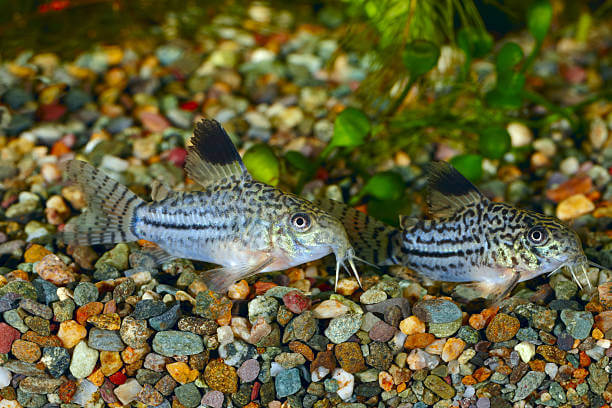How To Breed Cory Catfish?

Corydoras catfish, affectionately known as “cory cats,” is a captivating addition to any freshwater aquarium. These peaceful bottom-dwellers are adorable and incredibly helpful, keeping your tank sparkling clean with their constant scavenging. But did you know you can witness the miracle of life firsthand by breeding these delightful fish? If you’re a novice considering buying or already have these charming creatures, this guide unveils the secrets of successful Corydoras breeding!
Corydoras Fun Facts:
- These tiny charmers come in a dazzling array of colors and patterns, with over 200 known species!
- Their lifespan can range from 5 to 10 years, offering years of companionship.
- They’re omnivores, enjoying sinking pellets, algae wafers, and even the occasional bloodworm treat.
- Corydoras are social creatures, thriving in groups of 6 or more. They even get along well with other peaceful fish!
Breeding Corydoras Catfish: A Responsible Guide to Witnessing the Miracle of Life
The playful antics and peaceful presence of Corydoras catfish, affectionately known as “cory cats,” have captivated aquarists worldwide. But have you ever considered witnessing the miracle of life firsthand by breeding these charming bottom-dwellers? While responsible breeding requires careful planning and knowledge, it can be a rewarding experience for any fish enthusiast.
Before We Begin: Responsible Breeding Matters
It’s crucial to emphasize responsible breeding practices before diving in. Overbreeding any fish can strain your resources and negatively impact animal welfare. Ensure you have a plan for the fry before embarking on this journey. Consider offering them to other responsible aquarists or local fish stores.
Know Your Corydoras:
Different Corydoras species have varying breeding requirements and temperaments. Start by researching the specific needs of your chosen species. Popular choices for beginners include Panda Corys, Bronze Corys, and Julii Corys.
Setting the Stage: Water Parameters and Tank Setup
Mimicking their natural environment is key to successful breeding. Research the ideal water temperature, pH, hardness, and conductivity for your specific Corydoras. Prepare a dedicated breeding tank with a gentle filter, a heater to maintain stable temperatures (usually around 75°F), and soft lighting. Choose a fine sand or gravel substrate for egg-laying and add some live plants for hiding places. Aim for slightly acidic water with a pH between 6.0 and 7.0.
Selecting Your Breeders:
Choose healthy, mature Corydoras (ideally a year old or older, over 2.5 inches long) with a mix of males and females. Males are generally slimmer with longer fins, while females are more rounded with shorter fins. Observing their behavior can also help differentiate them, as males tend to chase and nudge females during courtship.
Triggering the Magic: Simulating the Rains
Mimic their natural breeding season by slightly lowering the water temperature by a few degrees and performing frequent small water changes. This simulates the arrival of rain in their native habitat and can trigger breeding behavior. Offer a varied diet to keep them in top condition.
The Dance of Love: Witnessing the “T-Pose”
When conditions are right, a fascinating display unfolds. The male will chase the female, performing a unique “T-pose” beside her to fertilize the eggs she carries. She then carefully attaches these sticky treasures to plants or other surfaces. However, Corydoras tend to snack on their eggs, so removing the parents after spawning is crucial.
Tiny Miracles Emerge: Hatching and Beyond
After a few days, witness the magic as tiny fry emerges from the eggs! Carefully remove any uneaten eggs to prevent water quality issues. Now comes the delicate part: caring for the fry.
Nurturing Microscopic Lives: Feeding and Growth
These microscopic marvels need infusoria or finely ground flakes for their first few days. As they grow, they switch to microworms and brine shrimp nauplii. Keep the water clean with frequent small water changes and monitor their growth. Once they reach maturity (around 3-4 months old), gently transfer them to a larger tank.
Ethical Considerations: Culling and Beyond
While some breeders cull weak or deformed fry, this is a sensitive topic with ethical considerations. Research and decide what aligns with your values before proceeding. Remember, providing all your fish with a good quality of life is paramount.
Beyond Breeding: Sustainable Practices
Always encourage responsible sourcing of fish and avoid wild-caught specimens. Support reputable breeders who prioritize fish welfare and genetic diversity.
Embrace the Journey, Breed Responsibly
Breeding Corydoras can be a fascinating and rewarding experience. Remember, thorough research, careful planning, and responsible practices are essential for success. With dedication and knowledge, you can witness the miracle of life and contribute to the responsible enjoyment of this captivating hobby.